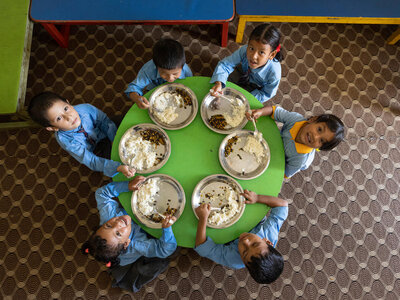Nepal
- 25%
- of children under 5 are stunted
- Around 20%
- of people live below the national poverty line
- 10th country
- most affected by climate risk from 2000 to 2019
Nepal ratified its new constitution in 2015 in a peace process that restructured the country as a federal democratic republic following a decade-long conflict that ended in 2006. The 2018 Right to Food Act enshrines food as a fundamental right of every citizen, a decisive step towards meeting Nepal’s commitments to address the country’s challenges related to malnutrition and food insecurity.
Nepal ranks 146 out of 192 countries in the 2022 Human Development Index. However, it remains the third lowest ranked country in South Asia. The country has significantly reduced multidimensional poverty from 30.1 percent in 2014 to 17.4 percent in 2019, although 5 million people remain multidimensionally poor. Stunting prevalence went down by 11 percentage points from 36 percent in 2016 to 25 percent in 2022, yet one in four children under 5 are stunted. Vitamin and mineral deficiencies are also widespread, with 33 percent of pregnant women anemic. WFP’s Fill the Nutrient Gap Analysis (2021) reported that 23.1 percent of the Nepalese population do not consume a nutritiously adequate diet.
What the World Food Programme is doing in Nepal
-
Food assistance in emergencies
-
WFP supports the government’s emergency preparedness and response efforts to ensure that those affected have immediate access to adequate food and nutrition. In addition, WFP provides recovery support through food and cash assistance to vulnerable communities as they build assets and restore livelihoods in the aftermath of disasters. WFP is also strengthening the government’s emergency response capacity by establishing critical logistics infrastructure including Humanitarian Staging Areas, capacity building of first responders, and flood early warning systems and multi-hazard early warning systems.
-
Enhance nutrition, school meals, and fortification
-
WFP supports the government’s efforts to prevent and address malnutrition through supporting health and nutrition programmes targeting children under 5 and pregnant and breastfeeding women and girls, and supporting the provision of nutritious school meals to children in chronically food-insecure areas. WFP is also working closely with the government to integrate the School Meals Programme into the national social protection framework and make fortified rice available to both schools and the broader population.
-
Sustainable food systems for climate-vulnerable and food-insecure communities
-
WFP helps food-insecure communities to benefit from critical infrastructure that improves access to basic services. WFP also supports climate-vulnerable communities in preparing for, mitigating the impacts and recovering back from shocks. This includes developing climate-resilient community infrastructure, enhancing agricultural productivity and livelihoods, preparedness for climate shocks, and setting up early-warning systems through last-mile services made accessible to end-users at the community level.
-
Policy and evidence generation
-
WFP enhances food security and nutrition policy coordination at the federal, provincial, and local government levels to improve food security governance and promote the crucial link between evidence and policy. WFP supports national food security monitoring and analysis to ensure an evidence-based design and implementation of emergency and development programmes. WFP also produces regular reports on household food security, food prices, and agriculture in Nepal.
Nepal news releases
Go to pagePartners and donors
Find out more about the state of food security in Nepal
Visit the food security analysis pageContacts
Office
P.O.Box 107, Bhanimandal, Ekantakuna, Jawalakhel, Lalitpur – 4,
Kathmandu
Nepal






